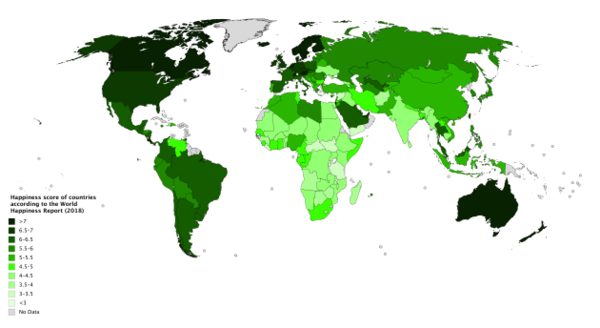Today, personal trackers are everywhere. Activity bands track our heart rate, sleep, and steps. Applications like RescueTime measure your productivity online. Yet, when most of us think about what we want in life we don’t say “get 10,000 steps a day” or “spend less unproductive time online”. The #1 goal is simply, “be happy”. It can be difficult to reach this goal without any measurements. When we do not measure happiness and wonder if we’re on the right track, there is a tendency to envision where we want to be and compare with where we are, which often comes up short. Stated pointedly in the movie 20th Century Women, “Wondering if you’re happy is a great shortcut to just being depressed.”
However, tracking happiness isn’t about wondering if you’re happy. It’s about determining the factors that make your life a little better. Peer-researched positive psychology can find many factors that help on average, but the only way to know how your environment, habits, and decisions are impacting your life satisfaction is to measure it yourself. Here are a few methods you can use in your life to better track your happiness.
1. Use a Survey
With the number of universities studying positive psychology, we don’t need to reinvent the wheel. There are a number of surveys designed for measuring happiness and life fulfillment. For example, you may have seen this happiness map.

The World Happiness Report, which created this map, gathers several economic factors along with one happiness question to color in the countries. In English the question is “Please imagine a ladder, with steps numbered from 0 at the bottom to 10 at the top. The top of the ladder represents the best possible life for you and the bottom of the ladder represents the worst possible life for you. On which step of the ladder would you say you personally feel you stand at this time?”
For a personal survey, one question probably isn’t enough. You can use the Oxford Happiness Questionnaire or the PANAS scale. The Positive Psychology Program has a list of some commonly-used surveys. You can take these surveys yourself on a regular basis to help identify changes over time.
There are many academic surveys that have been used across the world to measure happiness. Each has their own specific use cases and facets of happiness they are designed to study. Using an established academic survey for happiness will allow you to compare your own results to large populations and and provide best practices for analyzing the data. However, finding the survey that asks just the right questions for your situation and fits into your daily life can be difficult. You might consider creating your own custom solution.
2. Create a Personal Tracker
You know your personal goals and how you feel about your progress better than anyone. A more personalized approach is to create your own survey. In this spirit, I created a mood tracker to see how my web activity impacted my mood.
![]()
It’s not the prettiest application available, but since I made it myself, I was able to edit the questions to be exactly what I wanted to measure. I included only the questions I wanted and had it prompt me every 15 minutes I was browsing the web.
Your personal solution doesn’t have to be technical like my mood tracker. You can create your own survey or download and customize one of the many mood tracker apps available for your phone. If you don’t feel like installing an app to to track your mood throughout the year, another great way of keeping track of your thoughts and feelings is a simple journal. There are a great number of available formats from gratitude journals to bullet journals. You can also use free form and just write your thoughts every day. With a journal, you can use text mining techniques to analyze how your writing changes over time. Sentiment analysis can be used to get an idea of your feeling while you wrote. You can also try traditional research coding methods to do qualitative analysis on your journal, but it might be uncomfortable to have an unbiased bystander to help code your personal journals.
3. Measure Indicators
If answering survey questions, recording your mood, and writing journal entries doesn’t sound like something you can stick to, another great way to measure happiness is through the factors that have been shown to make people happy, such as exercise, helping others, and being engaged in a community. Rather than trying to create surveys and journal entries to measure happiness directly, we can measure progress on these indicators. If you do decide to keep a journal or your own personal happiness survey, you might want to consider adding these measures to them.
Some happiness surveys even take this into account. For example, pursuit-of-happiness.org has created a skills-based happiness quiz, which claims to measure “what you are actually doing that is strongly related to various correlates of Psychological Well Being.”
Sometimes these measures are easy to track. For example, If you have a fitness tracker, you don’t need to log every exercise; your watch does it for you. However, many measures take manual effort. Keeping track of how many friends you made or how engaged you are in the community would likely require as much manual effort as answering a survey every week.
The options mentioned here are broad strokes and you can find more specific options with additional research. However, remember that the most important factor is to pick something you can stick to.
Happiness is not an easy thing to measure. There aren’t any fitness bands that can read your emotions. Yet, by keeping some measure of your personal happiness you can get a better idea of what’s really important to you. Whether you use a peer review happiness index or a daily journal, keeping track of your thoughts and feelings can help you get closer to the illusive goal of personal happiness.